The nurse is caring for a client with Cushing's triad. The nurse expects the client to have:
Irregular respirations, bradycardia, and widening pressure
Hypotension, jugular venous distention, and mufled heart sound
Fixed pupils, hypertension, and bradycardia
Bradycardia, hypotension, and bradypnea
The Correct Answer is C
Choice A rationale: Irregular respirations, bradycardia, and widened pulse pressure might indicate increased intracranial pressure.
Choice B rationale: This set of symptoms is often seen in cardiac tamponade and is referred to as the Beck’s triad and not Cushing's triad.
Choice C rationale: Cushing's triad is a set of clinical signs associated with increased intracranial pressure (ICP) and typically includes bradycardia (slow heart rate),
hypertension (elevated blood pressure), and irregular breathing patterns. Fixed pupils can also be present in some cases, but it's important to note that this triad is not always consistently present and may vary from person to person.
Choice D rationale: This set of symptoms describes symptoms of shock, not specifically Cushing's triad.

Nursing Test Bank
Naxlex Comprehensive Predictor Exams
Related Questions
Correct Answer is C
Explanation
Choice A rationale: This symptom typically indicates secondary syphilis, not gonorrhea.
Choice B rationale: Warts on the genitals suggest a different sexually transmitted infection caused by HPV, not gonorrhea.
Choice C rationale: A discharge from the penis is a common symptom of gonorrhea and often prompts individuals to seek medical attention.
Choice D rationale: While discomfort can be associated with gonorrhea, the primary presenting symptom often involves discharge rather than specific lesions.

Correct Answer is {"dropdown-group-1":"A","dropdown-group-2":"D"}
Explanation
Choice A rationale: A three-point gait is used when one leg is weaker or injured and cannot bear weight. The client should place the crutches about 12 inches in front of the feet and lean forward on the crutches. Then, the client should lift the injured leg and
swing the body forward between the crutches, landing on the uninjured leg. The client should not put any weight on the injured ankle, as ordered by the physician.
Choice B rationale: A four-point gait is used when both legs can bear some weight, but one is weaker than the other.
Choice C rationale: A swing-through gait is used when both legs can bear weight, but need assistance with balance and coordination.
Choice D rationale: A two-point gait is used when both legs have equal strength and can bear full weight.
Whether you are a student looking to ace your exams or a practicing nurse seeking to enhance your expertise , our nursing education contents will empower you with the confidence and competence to make a difference in the lives of patients and become a respected leader in the healthcare field.
Visit Naxlex, invest in your future and unlock endless possibilities with our unparalleled nursing education contents today
Report Wrong Answer on the Current Question
Do you disagree with the answer? If yes, what is your expected answer? Explain.
Kindly be descriptive with the issue you are facing.
